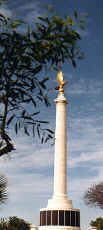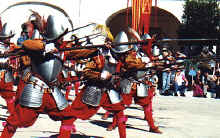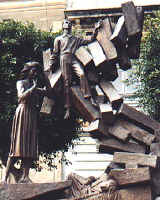
![]()
Speaking of the heroic pilots who won the Battle of Britain, Churchill said: "Never has so much been owed by so many to so few." His words could have applied equally to the defenders of Malta, both during WWII and nearly 400 years earlier.
The "Great Siege"
In 1492 the last of the Moors were driven from Europe, but the Turks under Suleyman became the next threat to Christendom. During the 1500s they were the scourge of the Mediterranean, pillaging at will, and carrying off women and able-bodied men to slavery. Yet they knew that their dream of total supremacy could not be realized as long as their sworn enemies, the Knights and their fleet, held Malta. Over a 15-year period they raided Malta and Gozo repeatedly, at one point killing or enslaving the entire population of Gozo. Then in 1565 they attacked the remaining defenders (about 9,000 locals and less than 100 Knights) with a force of 35,000 men and 180 ships. Reportedly only about 600 defenders survived, but when the Turks’ leader was killed, they finally gave up and went home, never again to threaten Europe. That was the first great debt that we owe to Malta.
Crowned heads of Europe, including Protestant Elizabeth I, showered the Knights with money and gifts. A Golden Age began, as the Knights built Valletta and brought peace and stability to the islands. Gradually but inevitably though, they fell victim to their own success, and a gradual slide into decadence began.
By the end of the 1700s, the world had changed. Malta had ceased to be a military influence, and after a brief occupation by Napoleon’s troops, it became a British protectorate and colony.

![]()
Vestiges of Greatness
The Order of Saint John of Jerusalem exists today, with their leader reporting directly to the Pope, but it bears little resemblance to the original Knights. They maintain and sponsor a variety of medical facilities and services around the world, including "St. John’s Ambulance" in Canada. The new Order’s headquarters is in Rome; the palaces of the individual national groups in Valletta now serve other functions; and the Grand Knight’s Palace has become Malta’s Parliament. Next door is their fascinating museum, with authentic arms, armour, and carriages; and their memory is also kept alive by a local historical society.
Just as War of Independence and Civil War buffs have kept the uniforms and military tactics of those eras alive in the USA, so has this group preserved the spirit of the Knights of Malta. Using the facilities of old Fort St Elmo, they hold a monthly "parade, inspection and demonstration of skills", which I was fortunate to attend. The uniforms and flags are authentic replicas of those worn by their seven national groupings, and the mock pike-and-halberd skirmishes and cannon firings are entertaining to say the least. The "drill" is more or less predictable, having been taken straight from the British Army Drill Manual. Overall, it’s a great way to spend a Sunday morning!

![]()
The Battle of Malta
By 1941 RAF planes from Malta were sinking Axis supply ships headed for North Africa. On top of that, the Germans knew that if Rommel were defeated the Allies would use Malta as a stepping stone to invade Italy, so they set out to bomb it into oblivion.
The 1942 Battle of Malta lasted three times as long as the better-known Battle of Britain. More than 6,000 tons of bombs were dropped, thousands were killed, and the people nearly starved to death. The dockyard city of Senglea was reduced to literally nothing but rubble, from which it rose, proudly, like a phoenix after the War. Today their Coat of Arms proudly bears the inscription "Senglea – The Unbeaten City".
Hundreds of RAF, RCAF and other Allied airmen lost their lives. Their heroism is remembered in a beautiful memorial at the entrance to Valletta, and in the touchingly simple War Museum located within the walls of Fort St Elmo. Also on display there are two of Malta’s greatest treasures: the original George Cross from King George VI, and the Citation from President Roosevelt, both awarded to all its citizens. Reproductions have been placed in the walls at the entrance to Parliament for all to see. There is also a photo of the Italian navy, at anchor with guns plugged, having surrendered in Malta.
As we know, from Malta the Allies went on to plan the invasion of Sicily and the Italian campaign, which hastened the end of the War. Truly, "never has so much been owed by so many to so few."
Afterword
I wouldn’t want my interest in history to leave you with the impression that Malta is a land that lives only in the past. In fact, there’s lots more to see, the weather tends to be good in the winter, the people are friendly, and if you can get there during the pre-Lenten season, you will enjoy one of Europe’s most colourful and lively (but strictly family-oriented!) carnivals. Malta is definitely a place not to miss.